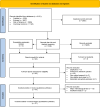Artificial Intelligence Applied to Ultrasound Diagnosis of Pelvic Gynecological Tumors: A Systematic Review and Meta-Analysis
- PMID: 40340944
- PMCID: PMC12180770
- DOI: 10.1159/000545850
Artificial Intelligence Applied to Ultrasound Diagnosis of Pelvic Gynecological Tumors: A Systematic Review and Meta-Analysis
Abstract
Introduction: The objective of this study wasto perform a systematic review on artificial intelligence (AI) studies focused on identifying and differentiating pelvic gynecological tumors on ultrasound scans.
Methods: Studies developing or validating AI models for diagnosing gynecological pelvic tumors on ultrasound scans were eligible for inclusion. We systematically searched PubMed, Embase, Web of Science, and Cochrane Central from their database inception until April 30, 2024. To assess the quality of the included studies, we adapted the QUADAS-2 risk of bias tool to address the unique challenges of AI in medical imaging. Using multilevel random-effects models, we performed a meta-analysis to generate summary estimates of the area under the receiver operating characteristic curve (AUC), sensitivity, and specificity. To provide a reference point of current diagnostic support tools for ultrasound examiners, we descriptively compared the pooled performance to that of the well-recognized ADNEX model on external validation. Subgroup analyses were performed to explore sources of heterogeneity.
Results: From 9,151 records retrieved, 44 studies were eligible: 40 on ovarian, 3 on endometrial, and 1 on myometrial pathology. Overall, 95% were at high risk of bias - primarily due to inappropriate study inclusion criteria, the absence of a patient-level split of training and testing image sets, and no calibration assessment. For ovarian tumors, the summary AUC for AI models distinguishing benign from malignant tumors was 0.89 (95% CI: 0.85-0.92). In lower risk studies (at least three low-risk domains), the summary AUC dropped to 0.87 (95% CI: 0.83-0.90), with deep learning models outperforming radiomics-based machine learning approaches in this subset. Only five studies included an external validation, and six evaluated calibration performance. In a recent systematic review of external validation studies, the ADNEX model had a pooled AUC of 0.93 (95% CI: 0.91-0.94) in studies at low risk of bias. Studies on endometrial and myometrial pathologies were reported individually.
Conclusion: Although AI models show promising discriminative performances for diagnosing gynecological tumors on ultrasound, most studies have methodological shortcomings that result in a high risk of bias. In addition, the ADNEX model appears to outperform most AI approaches for ovarian tumors. Future research should emphasize robust study designs - ideally large, multicenter, and prospective cohorts that mirror real-world populations - along with external validation, proper calibration, and standardized reporting.
Keywords: Artificial intelligence; Endometrial cancer; Gynecological oncology; Meta-analysis; Myometrial cancer; Ovarian cancer; Ultrasound.
© 2025 The Author(s). Published by S. Karger AG, Basel.
Conflict of interest statement
B.V.C., D.T., and W.F. serve as members of the Steering Committee of the International Ovarian Tumor Analysis (IOTA) consortium, with B.V.C. and D.T. being involved in the development of the ADNEX model. All other authors have no conflicts of interests.
Figures



Similar articles
-
Artificial Intelligence in Ultrasound-Based Diagnoses of Gynecological Tumors: A Systematic Review.Cureus. 2025 Jun 12;17(6):e85884. doi: 10.7759/cureus.85884. eCollection 2025 Jun. Cureus. 2025. PMID: 40656430 Free PMC article. Review.
-
Signs and symptoms to determine if a patient presenting in primary care or hospital outpatient settings has COVID-19.Cochrane Database Syst Rev. 2022 May 20;5(5):CD013665. doi: 10.1002/14651858.CD013665.pub3. Cochrane Database Syst Rev. 2022. PMID: 35593186 Free PMC article.
-
Drugs for preventing postoperative nausea and vomiting in adults after general anaesthesia: a network meta-analysis.Cochrane Database Syst Rev. 2020 Oct 19;10(10):CD012859. doi: 10.1002/14651858.CD012859.pub2. Cochrane Database Syst Rev. 2020. PMID: 33075160 Free PMC article.
-
Duplex ultrasound for diagnosing symptomatic carotid stenosis in the extracranial segments.Cochrane Database Syst Rev. 2022 Jul 11;7(7):CD013172. doi: 10.1002/14651858.CD013172.pub2. Cochrane Database Syst Rev. 2022. PMID: 35815652 Free PMC article.
-
Systemic pharmacological treatments for chronic plaque psoriasis: a network meta-analysis.Cochrane Database Syst Rev. 2021 Apr 19;4(4):CD011535. doi: 10.1002/14651858.CD011535.pub4. Cochrane Database Syst Rev. 2021. Update in: Cochrane Database Syst Rev. 2022 May 23;5:CD011535. doi: 10.1002/14651858.CD011535.pub5. PMID: 33871055 Free PMC article. Updated.
Cited by
-
Artificial Intelligence in Ultrasound-Based Diagnoses of Gynecological Tumors: A Systematic Review.Cureus. 2025 Jun 12;17(6):e85884. doi: 10.7759/cureus.85884. eCollection 2025 Jun. Cureus. 2025. PMID: 40656430 Free PMC article. Review.
References
-
- Ferlay J, Steliarova-Foucher E, Lortet-Tieulent J, Rosso S, Coebergh JWW, Comber H, et al. Cancer incidence and mortality patterns in Europe: estimates for 40 countries in 2012. Eur J Cancer. 2013;49(6):1374–403. - PubMed
-
- Heintz A, Odicino F, Maissonneuve P, Quinn M, Benedet J, Creasman W, et al. Carcinoma of the ovary. Int J Gynecol Obstet. 2006;95(S1):S161–92. - PubMed
-
- Van Holsbeke C, Daemen A, Yazbek J, Holland TK, Bourne T, Mesens T, et al. Ultrasound experience substantially impacts on diagnostic performance and confidence when adnexal masses are classified using pattern recognition. Gynecol Obstet Invest. 2010;69(3):160–8. - PubMed
-
- Van Calster B, Van Hoorde K, Valentin L, Testa AC, Fischerova D, Van Holsbeke C, et al. Evaluating the risk of ovarian cancer before surgery using the ADNEX model to differentiate between benign, borderline, early and advanced stage invasive, and secondary metastatic tumours: prospective multicentre diagnostic study. BMJ. 2014;349:g5920. - PMC - PubMed
Publication types
LinkOut - more resources
Full Text Sources
Miscellaneous

